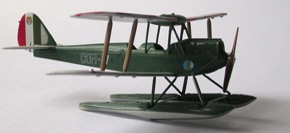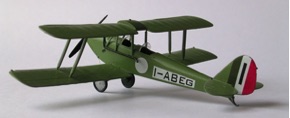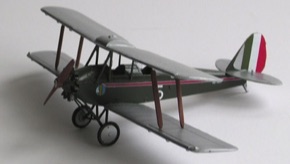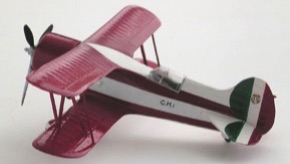Originally named Societá de Agostini e Caproni, this company was founded in 1908 by Count Battista 'Gianni' Caproni. It was famed for its large WWI aircraft such as the legendary Ca.3 bomber. In the inter-war period it reformed and was re-named Societá Italiana Caproni, Milano, incorporating Caproni Bergamaschi, Caproni Vizzola, Reggiane and Isotta Fraschini to become one of the largest group of companies in Italy. Only FIAT was comparable in size. The company struggled post-war with the only surviving remnant being Caproni Vizzola, whose assets were obtained by the Augusta group.
Caproni Ca.20. This aircraft has nothing to do with the Regia Aeronautica but deserves a mention. Gianni Caproni had this prototype built in 1914 and is one of the earliest examples of a monoplane fighter design. Despite showing exceptional promise during testing, the Italian government rejected this proposal as they wanted Caproni to focus on bomber production. The prototype was found in a barn at the Caproni family home and sold to the Museum of Flight in Seattle 1999, still in its original, untouched and remarkably well preserved condition. Spin Models released a reasonable 1/48 resin kit but is probably OOP by now. Choroszy Modelbud have a delicate little 1/72 resin kit in their catalogue.
Caproni Ca.100. A biplane based on the Tiger Moth for which Caproni had obtained a licence. With its shorter span upper wing, a feature seen on a few Caproni biplanes, it was the standard trainer of the Regia Aeronautica and earned the knickname of 'caproncino'. Choroszy Modelbud have produced a multitude of Ca.100 resin kits in 1/72 scale covering nearly all known types. Fly Models have also released a quartet of neat 1/72 injection moulded kits with each sharing the same sprues. Although OOP, Legato also produced 1/72 & 1/48 resin kits of the Colombo engined variant. GAE printed a useful mini reference source for this aircraft, but it too is out of print.
Caproni Ca.101. Based on the Ca.97, this trimotor aircraft was originally designed as an airliner. The first series were powered by either Lynx, Piaggio P.VII or Jupiter radials. The bis variant had increased dimensions and the D.2 variant had more powerful Alfa Romeo D.2 radials. As well as airline duties, 72 Ca.101's were used by the Regia Aeronautica as a bomber and as transport. They were all retired by 1939. Two 1/72 kits were released. The RCR resin kit was re-issued by Italiankits and the Fly/LF Models injection moulded kit, which share the same moulds, provide a choice of 7 or 9 cylinder radials.
Caproni Ca.102. This aircraft was a variant of the Ca.101 trimotor powered by a pair of Jupiter radials. It earned the nickname of Pinocchio thanks to its altered nose profile, which had four machine guns and a bomb aimers window. The Regia Aeronautica had 34 built but they were retired by 1939. No kits are known but a donor Ca.101 kit could make an ideal conversion project.
Caproni Ca.111. A variant of the Ca.101 tri-motor used mainly for long range reconnaissance. First flown in 1932, it was powered by an Isotta Fraschini Asso 18 cylinder 'W' engine and more than 150 were built, including an idrovolante. It had a higher top speed compared to the Ca.101 & Ca.133 and was used extensively by the Regia Aeronautica. Broplans 1/72 vacuform kit is the only current kit known of this aircraft.
Caproni Ca.113. A tidy looking two-seat trainer biplane with an elegant streamlined fuselage. Many records were set in various versions of this aircraft including those for altitude, distance & endurance. Its largest user was the Bulgarian Air Force, where Caproni established the Kaproni Bulgarski divison to build 107 "Chuchuliga" aircraft. Planet Models have released a nicely moulded 1/48 resin kit of the single seat version with decals for a Peruvian machine and the sole surviving aircraft I-MARY that resides in the Volandia Park and Aviation Museum in Milan.
Caproni Ca.114. A very capable 1933 single seat biplane design based on the Ca.113. It was not accepted by the Regia Aeronautica despite good performance during evaluation tests. Peru placed an order for 12 aircraft which saw active service until the last machines were scrapped in 1944. Planet Models have produced a good quality 1/48 resin kit with Peruvian markings.
Caproni Ca.133. A more efficient development of the Ca.101 tri-motor that saw widespread use. First flown in 1934, its generous fuselage proportions made it ideal for light transport duties. It was also used as a bomber initially snf went to be used for troop transport & air ambulance duties. Post war it saw brief service with Ala Littoria was retired in 1947. Aviation USK produced a 1/72 vac-form kit of this plane but has been OOP for a while.The limited edition EVA Models 1/48 resin kit is also OOP. Broplan have recently released two 1/72 vacu-form kits with different markings.
Caproni Ca.134. Only 2 examples of this 1937 reconnaissance biplane were built. Powered by an Isotta Fraschini engine, it was tested at Guidonia but it was not selected by the Regia Aeronautica. No kits are known of this design.
Caproni Ca.161. Lt. Col. M. Pezzi broke the altitude record for a piston engined biplane back in 1937 in this very wide-span aircraft, a specially modified Ca.113. He flew a Ca.113bis a year later to reach 56,032ft, a record that still stands. Although discontinued, the Brach Models 1/48th resin kit is highly detailed and it included a standing figure of a suited-up Mario Pezzi, complete with a separately moulded pressurised helmet.
Caproni Ca.164. A two-seat 1938 biplane design complete with trademark smaller upper wing. It was designed to replace the Ca.100 in the training role. However, due to poor handling, it was considered unsuitable for this role and used for liaison purposes instead. The Dujin 1/72 resin kit is discontinued but the 1/72 Choroszy Modelbud resin is still current.
Caproni Ca.165. This single prototype was built in 1938. Intended as a fighter, it showed much promise when tested against the FIAT Cr.42 in mock dogfights but engine reliability issues and unfavourable comments from the pilots meant no orders were placed. There are no known kits of this aircraft.
The aircraft listed below were experimental prototypes.
Stipa-Caproni. One the oddest looking Italian aircraft ever built, this veritable "flying barrel" prototype was designed by ing. Luigi Stipa in 1932 after a lot of detailed research. His bold and original 'venturi’ concept worked extremely well with the prototype demonstrating very stable handling, even at slow speeds. Its maximum speed was only 81mph. Stipa wanted to pursue his ideas further but could not get any more backing. His ideas have some relevance to modern day ducted-fan and jet propulsion technology. The image used by Dujin on the packaging of their 1/72 resin kit was that of a 3/5 flying replica built in Australia, which made a series of short flights in 2001 thus reaffirming Stipa's highly original concept. The Dujin kit is now discontinued but it was not a very accurate kit. There is the 1/72 & 1/48 3-D printed kit by A.M.C. France but availability is limited.
Caproni CH.1. A short lived prototype biplane designed by ing. Antonio Chiodi in 1934. He piloted the aircraft on its first flight in 1935 where, despite being underpowered, it demonstrated a good rate of climb. After flipping on its back later that year in a landing accident the Regia Aeronautica lost interest and no orders were placed. Issue 88 of Aerofan has a good in-depth article of this aircraft. Now discontinued, the 1/72 Dujin kit had modelled the canopy incorrectly, the only serious fault of the model.
Campini-Caproni. ing. Secondo Campini developed his 'thermo-jet' theory during the 1930s and was finally able to join forces with Caproni to build his experimental prototype. With an Isotta Fraschini piston engine driving a forward compressor in the front section of the fuselage, a burner in the rear section was used to increase thrust. First flown in 1940 but flight tests did show up a few problems. The heat generated by the compressor meant the pilots had to fly with open cockpits to vent heat. As the aircraft's structural integrity could not be proven during development, speeds were kept relatively low. It's top recorded speed was a disappointing 320 mph. One complete aircraft is preserved at Vigna di Valle. Now out of print, the mini Ali d'Italia booklet proved just how inaccurate the 1/72 Delta2 model is. Maybe Valom should have used it to research their 1/72 injection moulded kit because it does not match the plans either.
Caproni Sauro-1. Built in 1933, this prototype tourer was also known as TRICAP (Trigone Caproni), named after its designer Emmanuale Trigona and its builder Caproni. It was a clean design with an inverted gull wing, powered by a Farina radial but, despite successful trials, there was no further development or orders placed. There are no known kits of this aircraft.
Campini-Caproni
Ca.111
Ca.133
Ca.114
Ca.113
Ca.161
Ca.134
Ca.165
Tricap
Ca.20

Model images are links to a build article
Ca.102
Ca.101







